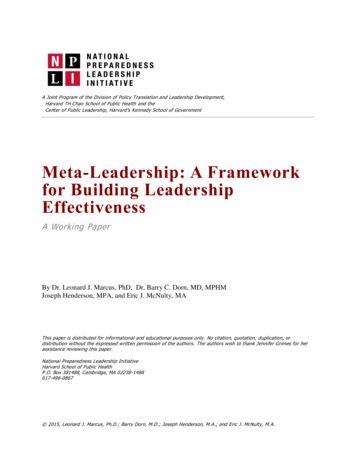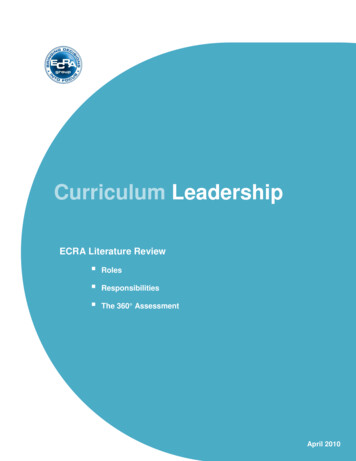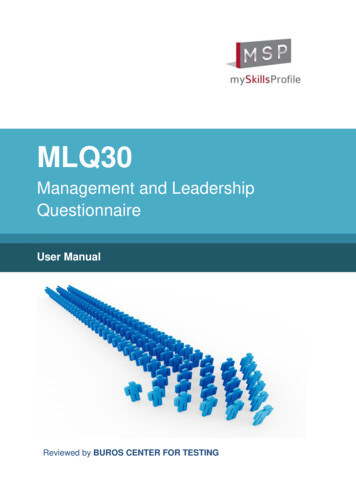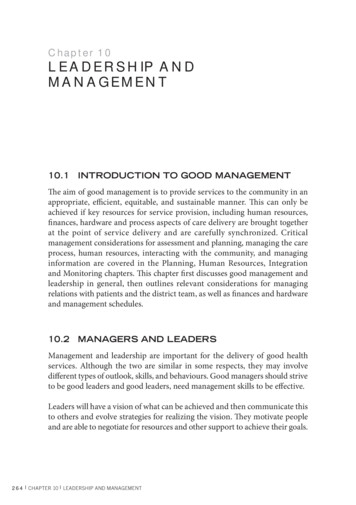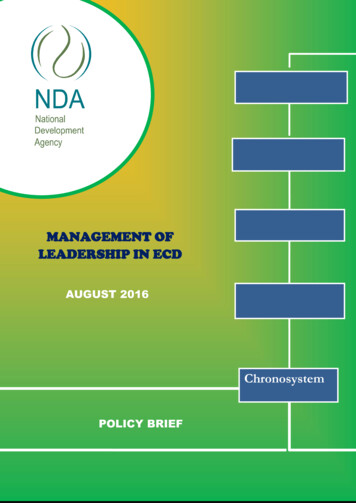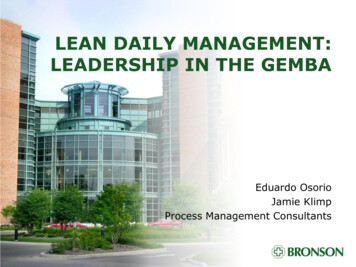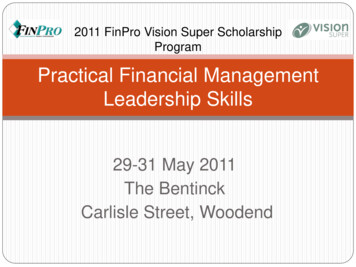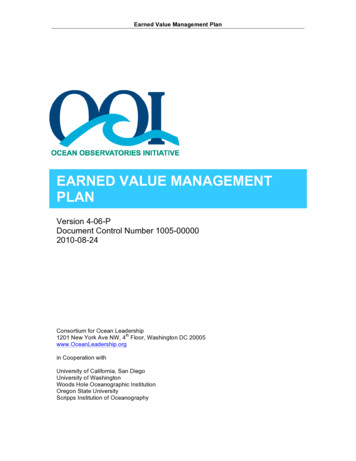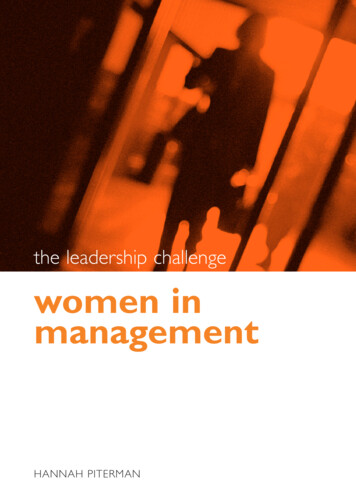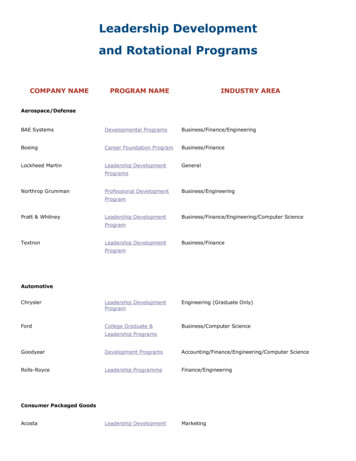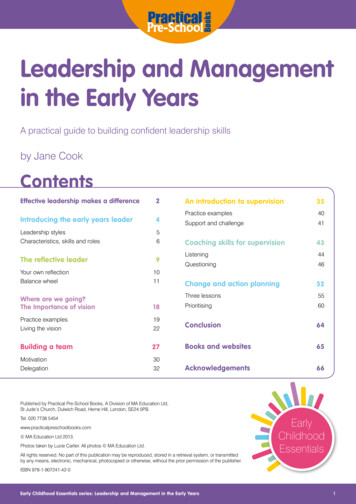
Transcription
BooksLeadership and Managementin the Early YearsA practical guide to building confident leadership skillsby Jane CookContentsEffective leadership makes a difference 2Introducing the early years leader 4Leadership styles Characteristics, skills and roles 56The reflective leader 9Your own reflection Balance wheel 1011An introduction to supervision 35Practice examples 40Support and challenge 41Coaching skills for supervision 43Listening 44Questioning 46Change and action planning 52Three lessons 55Where are we going?The Importance of vision 18Prioritising 60Practice examples Living the vision 1922Conclusion 64Building a team 27Books and websites 65Motivation Delegation 3032Acknowledgements 66Published by Practical Pre-School Books, A Division of MA Education Ltd,St Jude’s Church, Dulwich Road, Herne Hill, London, SE24 0PB.Tel: 020 7738 5454www.practicalpreschoolbooks.com MA Education Ltd 2013.Photos taken by Lucie Carlier. All photos MA Education Ltd.All rights reserved. No part of this publication may be reproduced, stored in a retrieval system, or transmittedby any means, electronic, mechanical, photocopied or otherwise, without the prior permission of the publisher.EarlyChildhoodEssentialsISBN 978-1-907241-42-0Early Childhood Essentials series: Leadership and Management in the Early Years 1
IntroductionEffective leadershipmakes a difference“Leadership and learning are indispensable to each other”in creating the quality to make that difference, is crucial.John F. Kennedy.All the research is telling us that the quality of provisionand children’s outcomes almost never exceeds the quality ofThis book has been written for everyone with a leadership role,leadership and management.or thinking about a leadership role, within the early years sector.It has been inspired by all the creative, passionate, clever,“ .there is no doubt that effective leadership andhard-working, funny and determined leaders I have worked withappropriate training for the leadership role is an increasinglyduring the past thirty years.important element in providing high quality provision for theearly years” Siraj-Blatchford and Manni (2007).Working in the early years, we know that good qualityeducation and care makes a difference to children’s livesand that this continues to have positive impact many yearsafter the child has left the setting. The role of the leaderWhy leadership inthe early years matters“We must be the change we wish to see in the world”Mahatma Gandhi.Those of us working in early years have always known howimportant our work is. We know that a child is only a baby, atoddler, a young child once – and it’s vital that we make thatexperience the very best possible for every child. We alsoknow that early childhood is the foundation upon which allfuture development depends. We are rightly proud when ouryoung children move to a primary school confident and excitedabout their own abilities and feeling secure about their place inthe world.The greater the change and uncertainty, the more important it isto hold on to your core values about early childhood education.These are expressed in the EYFS as:Theme: A Unique ChildPrinciple: Every child is a competent learner from birth who canbe resilient, capable, confident and self-assured.Every child is a competent learner from birth, who canbe resilient, capable, confident and self-assured2 Theme: Positive RelationshipsEarly Childhood Essentials series: Leadership and Management in the Early Years
Effective leadership makes a differencePrinciple: Children learn to be strong and independent froma base of loving and secure relationships with parents and/ora key person.Theme: Enabling EnvironmentsPrinciple: The environment plays a key role in supporting andextending children’s development and learning.Theme: Learning and DevelopmentPrinciple: Children develop and learn in different ways and atdifferent rates and all areas of Learning and Development areequally important and interconnected.Lasting impactSince the beginning of the 21st Century there has beensteadily increasing interest from outside the sector in what canbe achieved through high quality early years education andAs a leader in the early years you makea difference for children and their familiescare. For example, in the UK this has led to the introduction offree nursery education (initially for all three- and four-year-oldsand most recently 40% of two-year-olds), Children’s Centres(and the links this has helped to make with professionals inhealth and social care), the Early Years Professional Status,and fulfilling life. Your role as a leader in early years – workingGraduate Leader Fund, Early Years Foundation Stage and awith your team, with parents and with other professionals toreview of qualifications for the early years workforce.create the best possible provision for the children in your care,is therefore one of the most important jobs there is.Graham Allen, in his report on Early Intervention in 2011,put early years at the heart of his proposals to change theIn this book we will look at the knowledge, skills and attributeslife chances of those most at risk of underachievement. Theyou have as an early years practitioner and consider how youphotograph on the front cover of the report shows the brains ofcan develop them further to maximise your confidence, skillstwo three-year-old children. The first brain is of a child who hasand impact as a leader. The ideas and concepts are all firmlyhad the support and love needed to thrive, and the second of arooted in research, but the approach is always practical.child who has already suffered from extreme neglect. The size ofthe second child’s brain is significantly smaller than that of firstWe begin by looking at some different approaches tochild. The photograph was designed to shock, and it worked.understanding leadership and leaders and the implications forleading in the early years sector.“The rationale is simple: many of the costly and damagingsocial problems in society are created because we are notLater chapters go into more detail about the knowing, doinggiving children the right type of support in their earliest years,and being of different aspects of leadership, including thewhen they should achieve their most rapid development”importance of effective supervision.Graham Allen Report on Early Intervention 2011.What happens in the early years is not only of vital importancefor the well-being of our youngest children, it also has aprofound and lasting impact on their ability to have a happyEarly Childhood Essentials series: Leadership and Management in the Early Years 3
Chapter 1Introducing theearly years leader“Today a reader, tomorrow a leader”identified ten categories of ‘effective leadership practice’Margaret Fuller, 19th Century Women’s Rights Activist.(Institute of Education, 2007) as follows:Effective leadership practice1.Identifying and articulating a collective vision2.Ensuring shared understanding, meanings and goals3.Effective communication4.Encouraging reflection5.Monitoring and assessing practice6.Commitment to ongoing, professional development7.Distributed leadership8.Building a learning community and team culture9.Encouraging and facilitating parentThis is an exciting time to be working in early years, butit is also a challenging one for leaders and practitionersacross the sector. With more attention, comes increasedexpectation and accountability. With more opportunity, comesincreased complexity and demands on time. In an implicitacknowledgement of the range and scope of the leadershiprole in the early years, Iram Siraj-Blatchford and Laura Manniand community partnerships10. Leading and managing: striking the balance.This may look a daunting list, but the experience of anearly years practitioner provides an excellent foundationfor leadership. When practitioners move from working withchildren to leading adults, what is most often emphasised isthe difference between the two roles. There are differences,which mean there will be areas for learning and developmentto explore throughout this book. But there are also hugesimilarities. From working with children and their families we willhave developed a huge range of useful communication skills.In planning an environment we will have built up organisationaland planning skills. Observing children will have strengthenedour empathy and reflective skills. Above all, we will have carriedObserving children will have strengthenedour empathy and reflective skills4 with us a vision for quality that will continue to develop andinspire us throughout our professional lives.Early Childhood Essentials series: Leadership and Management in the Early Years
The reflective leaderHow well do you know your strengths and weaknesses?The benefits of feedbackMina, a new foundation stage coordinator in a busy primarywhat had been there before. In Mina’s Unknown area isschool. The previous coordinator was conscientious, buther unconscious assumption that being honest about herthe curriculum planning and environment had been gettingconcerns will turn everyone against her.a little tired.The result for Mina was that the she and the staffIn Mina’s Open area are her enthusiasm, her energy and herwere starting to drift further and further apart. Theypassion for making a difference for the children. This hasmisunderstood her communication style and didn’t tell herhelped her build up some positive relationships within theand so she thought that they were just ganging up againstteam who see her commitment and respect her knowledgeher and resistant to any change. What rescued the situationand expertise. In Mina’s Blind area is her tendency to talkwas feedback. The headteacher had observed a staffover people in meetings as she gets carried away with hermeeting and fed back to Mina what she had seen – thatenthusiasm. Some of the team are beginning to see thisthe staff did not understand her plans and that Mina wasn’tas a lack of respect for their views – and they are startinggiving them enough time to contribute to the discussions.to dig in their heels against some of the changes. She alsoTogether, Mina and the headteacher planned the next stafftalks very fast about things that she understands but canmeeting to ensure that everybody was involved and hadleave others behind, feeling nervous and unconfident abouttime to think and reflect about Mina’s suggestions – andtheir ability to take forward the proposed changes. In Mina’smake some of their own. The headteacher also encouragedHidden area is her worry that if the school had an inspectionMina to be honest with the team about where she saw theat the moment they would have a very poor result. She’squality of the setting at the moment – giving praise to whatnot very confident about giving negative feedback andwas going well, but explaining why they needed to makehad hoped to move quickly with the developments withoutsome changes to better meet the requirements of the EYFS.having to upset anyone by appearing to be critical about14 Early Childhood Essentials series: Leadership and Management in the Early Years
Coaching skills for supervisionDescribing feedback tableFeedbackCriticismWhere possible, builds on a strengthAlways focuses on the negativeLooks to the futureConcentrates on what happened in the pastSolution-focusedLooks for someone to blameAbout factsOften generalisesSays “and”Says “but”Is two-wayIs one-wayFor example: Jane is an experienced member of staff withLINKS WITH YOUR PRACTICEa particular way of putting up displays. They are neat andattractive. You’d like them to be more interactive and child-Using the feedback column as a guide, think about howcentred. What feedback are you going to give her?you could give feedback to these practitioners in thefollowing scenarios.Feedback – Possible things to sayHow could you help to change their behaviour and motivateWhere possible, builds on a strength: Thank you for putting upthem to work towards achieving their full potential?that new display in the entrance hall about the work we’ve beendoing on children’s speaking and listening. Your displays are alwaysl You’ve just taken over from an outstanding roombeautifully presented and show how you value the children’s work.leader. Everyone is very confident and clear aboutwhat they do and how, but you would like them toSolution-focused: I’d like us to build on that to include moretune-in a bit more to the children’s play, have a bitideas from the children about how to display their work, perhapsmore reflection time for adults and children.with some captions using their own words.l Your strongest practitioner has asked for feedbackLooks to the future: So, when we do the next display can weas she’s thinking about promotion. She’s veryget together first and think of some more ideas about how thisproud of her observations and wants to start withmight work?these. You’ve noticed that they are long and notalways to the point l Your new team member is regularly late. She alwaysPoint for reflectionhas an excuse as she comes through the door Think of a time when you have received feedback that hasl Your weak student doesn’t seem to be making muchbeen motivating.progress in her planning. She’s keen and willingand has a sensitive way of talking to the childrenNow think of a time when you have been given feedbackbut her file is almost empty and her ideas for focusthat has demotivated you.experiences for the children are usually rather dull50 (although she always says that she’s following theWhat did the person giving the feedback say or do? Whatchildren’s ideas).did you feel? What did you say or do?Early Childhood Essentials series: Leadership and Management in the Early Years
“Leadership and learning are indispensable to each other” John F. Kennedy. This book has been written for everyone with a leadership role, or thinking about a leadership role, within the early years sector. It has been inspired by all the creative, passionate, clever, hard-working, funny and determined leaders I have worked with during the past thirty years. Working in the early years, we .


